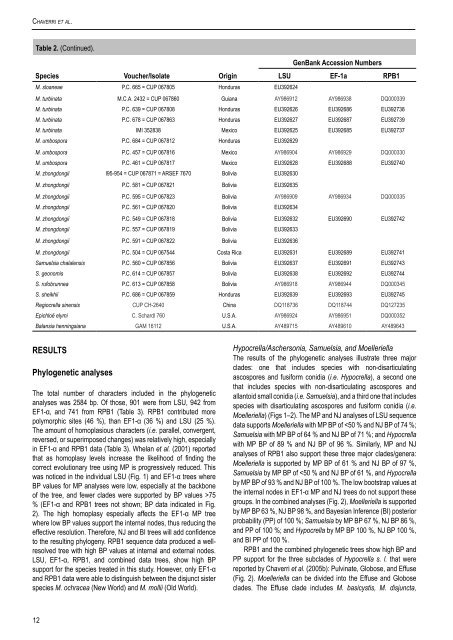Moelleriella, and Samuelsia - CBS
Moelleriella, and Samuelsia - CBS
Moelleriella, and Samuelsia - CBS
- No tags were found...
Create successful ePaper yourself
Turn your PDF publications into a flip-book with our unique Google optimized e-Paper software.
Ch av e r r i e t a l.Table 2. (Continued).GenBank Accession NumbersSpecies Voucher/Isolate Origin LSU EF-1a RPB1M. sloaneae P.C. 665 = CUP 067805 Honduras EU392624M. turbinata M.C.A. 2432 = CUP 067860 Guiana AY986912 AY986938 DQ000339M. turbinata P.C. 639 = CUP 067808 Honduras EU392626 EU392686 EU392738M. turbinata P.C. 678 = CUP 067863 Honduras EU392627 EU392687 EU392739M. turbinata IMI 352838 Mexico EU392625 EU392685 EU392737M. umbospora P.C. 684 = CUP 067812 Honduras EU392629M. umbospora P.C. 457 = CUP 067816 Mexico AY986904 AY986929 DQ000330M. umbospora P.C. 461 = CUP 067817 Mexico EU392628 EU392688 EU392740M. zhongdongii I95-954 = CUP 067871 = ARSEF 7670 Bolivia EU392630M. zhongdongii P.C. 581 = CUP 067821 Bolivia EU392635M. zhongdongii P.C. 595 = CUP 067823 Bolivia AY986909 AY986934 DQ000335M. zhongdongii P.C. 561 = CUP 067820 Bolivia EU392634M. zhongdongii P.C. 549 = CUP 067818 Bolivia EU392632 EU392690 EU392742M. zhongdongii P.C. 557 = CUP 067819 Bolivia EU392633M. zhongdongii P.C. 591 = CUP 067822 Bolivia EU392636M. zhongdongii P.C. 504 = CUP 067544 Costa Rica EU392631 EU392689 EU392741<strong>Samuelsia</strong> chalalensis P.C. 560 = CUP 067856 Bolivia EU392637 EU392691 EU392743S. geonomis P.C. 614 = CUP 067857 Bolivia EU392638 EU392692 EU392744S. rufobrunnea P.C. 613 = CUP 067858 Bolivia AY986918 AY986944 DQ000345S. sheikhii P.C. 686 = CUP 067859 Honduras EU392639 EU392693 EU392745Regiocrella sinensis CUP CH-2640 China DQ118736 DQ118744 DQ127235Epichloë elymi C. Schardl 760 U.S.A. AY986924 AY986951 DQ000352Balansia henningsiana GAM 16112 U.S.A. AY489715 AY489610 AY489643ResultsPhylogenetic analysesThe total number of characters included in the phylogeneticanalyses was 2584 bp. Of those, 901 were from LSU, 942 fromEF1-α, <strong>and</strong> 741 from RPB1 (Table 3). RPB1 contributed morepolymorphic sites (46 %), than EF1-α (36 %) <strong>and</strong> LSU (25 %).The amount of homoplasious characters (i.e. parallel, convergent,reversed, or superimposed changes) was relatively high, especiallyin EF1-α <strong>and</strong> RPB1 data (Table 3). Whelan et al. (2001) reportedthat as homoplasy levels increase the likelihood of finding thecorrect evolutionary tree using MP is progressively reduced. Thiswas noticed in the individual LSU (Fig. 1) <strong>and</strong> EF1-α trees whereBP values for MP analyses were low, especially at the backboneof the tree, <strong>and</strong> fewer clades were supported by BP values >75% (EF1-α <strong>and</strong> RPB1 trees not shown; BP data indicated in Fig.2). The high homoplasy especially affects the EF1-α MP treewhere low BP values support the internal nodes, thus reducing theeffective resolution. Therefore, NJ <strong>and</strong> BI trees will add confidenceto the resulting phylogeny. RPB1 sequence data produced a wellresolvedtree with high BP values at internal <strong>and</strong> external nodes.LSU, EF1-α, RPB1, <strong>and</strong> combined data trees, show high BPsupport for the species treated in this study. However, only EF1-α<strong>and</strong> RPB1 data were able to distinguish between the disjunct sisterspecies M. ochracea (New World) <strong>and</strong> M. mollii (Old World).Hypocrella/Aschersonia, <strong>Samuelsia</strong>, <strong>and</strong> <strong>Moelleriella</strong>The results of the phylogenetic analyses illustrate three majorclades: one that includes species with non-disarticulatingascospores <strong>and</strong> fusiform conidia (i.e. Hypocrella), a second onethat includes species with non-disarticulating ascospores <strong>and</strong>allantoid small conidia (i.e. <strong>Samuelsia</strong>), <strong>and</strong> a third one that includesspecies with disarticulating ascospores <strong>and</strong> fusiform conidia (i.e.<strong>Moelleriella</strong>) (Figs 1–2). The MP <strong>and</strong> NJ analyses of LSU sequencedata supports <strong>Moelleriella</strong> with MP BP of
















